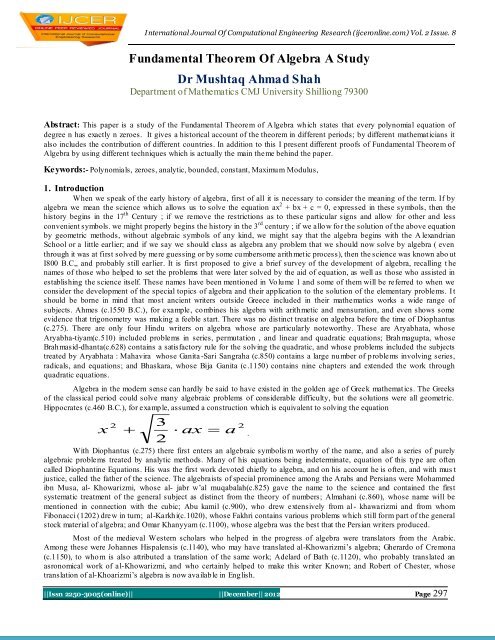ISSN: 2250-3005 - ijcer
ISSN: 2250-3005 - ijcer
ISSN: 2250-3005 - ijcer
Create successful ePaper yourself
Turn your PDF publications into a flip-book with our unique Google optimized e-Paper software.
International Journal Of Computational Engineering Research (<strong>ijcer</strong>online.com) Vol. 2 Issue. 8Fundamental Theorem Of Algebra A StudyDr Mushtaq Ahmad ShahDepartment of Mathematics CMJ University Shilliong 79300Abstract: This paper is a study of the Fundamental Theorem of Algebra which states that every polynomial equation ofdegree n has exactly n zeroes. It gives a historical account of the theorem in different periods; by different mathematicians italso includes the contribution of different countries. In addition to this I present different proofs of Fundamental Theorem ofAlgebra by using different techniques which is actually the main theme behind the paper.Keywords:- Polynomials, zeroes, analytic, bounded, constant, Maximum Modulus,1. IntroductionWhen we speak of the early history of algebra, first of all it is necessary to consider the meaning of the term. If byalgebra we mean the science which allows us to solve the equation ax 2 + bx + c = 0, expressed in these symbols, then thehistory begins in the 17 th Century ; if we remove the restrictions as to these particular signs and allow for other and lessconvenient symbols. we might properly begins the history in the 3 rd century ; if we allow for the solution of the above equationby geometric methods, without algebraic symbols of any kind, we might say that the algebra begins with the A lexandrianSchool or a little earlier; and if we say we should class as algebra any problem that we should now solve by algebra ( eventhrough it was at first solved by mere guessing or by some cumbersome arithmetic process), then the science was known abo utI800 B.C,, and probably still earlier. It is first proposed to give a brief survey of the development of algebra, recalling t henames of those who helped to set the problems that were later solved by the aid of equation, as well as those who assisted inestablishing the science itself. These names have been mentioned in Volume 1 and some of them will be referred to when weconsider the development of the special topics of algebra and their application to the solution of the elementary problems. Itshould be borne in mind that most ancient writers outside Greece included in their mathematics works a wide range ofsubjects. Ahmes (c.1550 B.C.), for example, combines his algebra with arithmetic and mensuration, and even shows someevidence that trigonometry was making a feeble start. There was no distinct treatise on algebra before the time of Diophantus(c.275). There are only four Hindu writers on algebra whose are particularly noteworthy. These are Aryabhata, whoseAryabha-tiyam(c.510) included problems in series, permutation , and linear and quadratic equations; Brahmagupta, whoseBrahmasid-dhanta(c.628) contains a satisfactory rule for the solving the quadratic, and whose problems included the subjectstreated by Aryabhata : Mahavira whose Ganita -Sari Sangraha (c.850) contains a large number of problems involving series,radicals, and equations; and Bhaskara, whose Bija Ganita (c.1150) contains nine chapters and extended the work throughquadratic equations.Algebra in the modern sense can hardly be said to have existed in the golden age of Greek mathematics. The Greeksof the classical period could solve many algebraic problems of considerable difficulty, but the solutions were all geometric.Hippocrates (c.460 B.C.), for example, assumed a construction which is equivalent to solving the equationx2322 ax a .With Diophantus (c.275) there first enters an algebraic symbolis m worthy of the name, and also a series of purelyalgebraic problems treated by analytic methods. Many of his equations being indeterminate, equation of this type are oftencalled Diophantine Equations. His was the first work devoted chiefly to algebra, and on his account he is often, and with mus tjustice, called the father of the science. The algebraists of special prominence among the Arabs and Persians were Mohammedibn Musa, al- Khowarizmi, whose al- jabr w‟al muqabalah(c.825) gave the name to the science and contained the firstsystematic treatment of the general subject as distinct from the theory of numbers; Almahani (c.860), whose name will bementioned in connection with the cubic; Abu kamil (c.900), who drew extensively from al - khawarizmi and from whomFibonacci (1202) drew in turn; al-Karkhi(c.1020), whose Fakhri contains various problems which still form part of the generalstock material of algebra; and Omar Khanyyam (c.1100), whose algebra was the best that the Persian writers produced.Most of the medieval Western scholars who helped in the progress of algebra were translators from the Arabic.Among these were Johannes Hispalensis (c.1140), who may have translated al-Khowarizmi‟s algebra; Gherardo of Cremona(c.1150), to whom is also attributed a translation of the same work; Adelard of Bath (c.1120), who probably translated anasronomical work of al-Khowarizmi, and who certainly helped to make this writer Known; and Robert of Chester, whosetranslation of al-Khoarizmi‟s algebra is now available in English.||Issn <strong>2250</strong>-<strong>3005</strong>(online)|| ||December|| 2012 Page 297
















